La monetización del contenido y la creación de seguidores se encuentran entre los millones de cosas con las que sueña un especialista en marketing de contenido. Pero, ¿y si tus videos no son tan útiles para llamar la atención? ¿Culparías a tu suerte o, en cambio, te esforzarías por aprender los aspectos básicos de la creación de videos?
Si está buscando desarrollar los elementos esenciales de la creación de videos, está en el lugar correcto. En este artículo, aprenderá cómo hacer un video en línea no solo de forma gratuita, sino también cómo crear videos que le hablen a su público objetivo como si estuvieran sentados al otro lado del escritorio.
Entonces, comencemos rápidamente.
Cómo hacer un video en línea gratis
Crear un video es relativamente fácil con Typito y en realidad solo puede tomar unos minutos.
Paso 1:Regístrese y cree un proyecto de video
- Vaya a typito.com y regístrese para obtener una cuenta gratuita. Puede registrarse utilizando su ID de correo electrónico o Google o Facebook. Elija lo que sea conveniente para usted.
- Una vez que se registre, será redirigido a la página de inicio de Typito. Haga clic en Nuevo proyecto .
- A continuación, verá una lista de formatos de video. Haga clic en el formato en el que desea crear su video presionando crear botón.
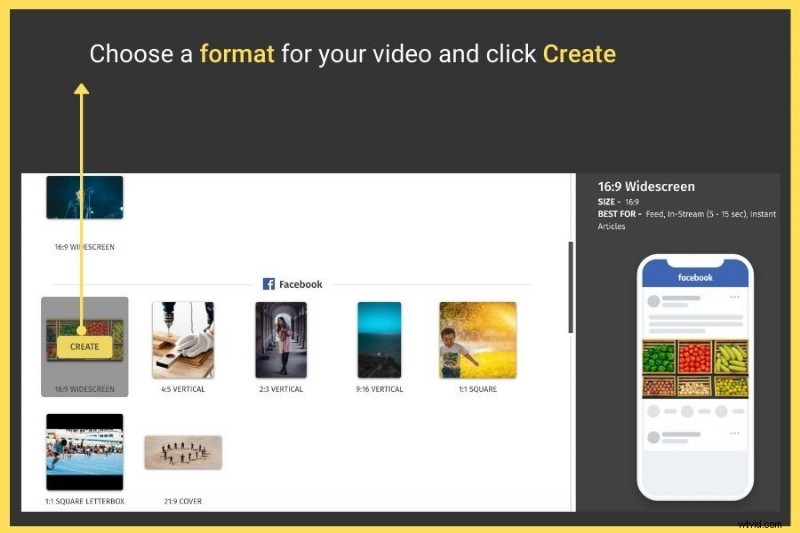
- Si no desea utilizar ninguno de los formatos predefinidos que se muestran y prefiere crear uno propio, haga clic en el botón que dice Crear formato personalizado en la parte superior.
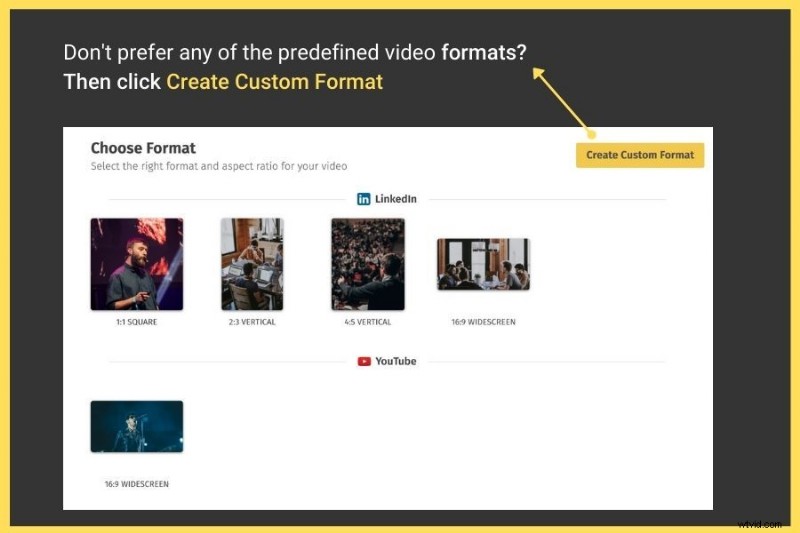
- Verá una ventana emergente, donde puede ingresar el nombre, propósito, ancho y alto (en píxeles) y relleno (en %) del formato de video. Una vez que haya ingresado todos los detalles, haga clic en Crear .
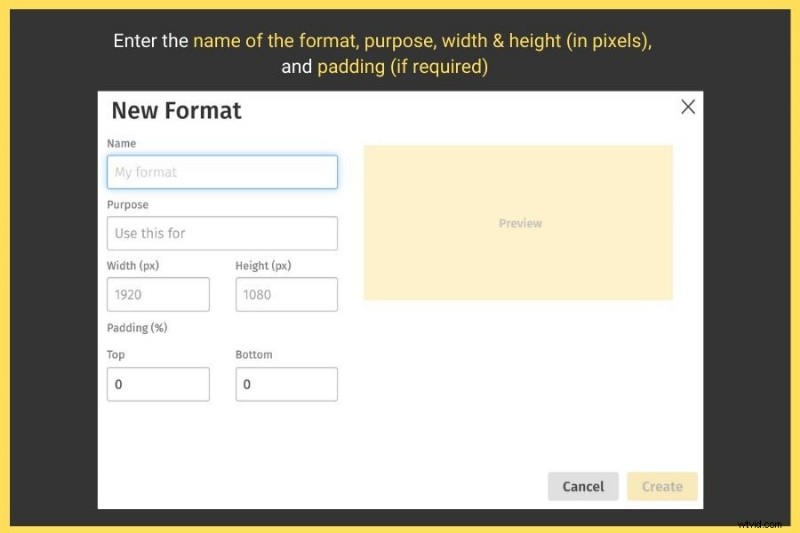
Paso 2:Sube el video desde tu computadora o elige del stock biblioteca multimedia
Independientemente del formato de video que elija (ya sea YouTube, Linkedin, Instagram, Twitter, Facebook o personalizado), será redirigido a una página que le brinda 2 opciones para importar un video:
- Subir: Le permite cargar un video desde su computadora
- Medios de archivo: Le permite seleccionar un video de la biblioteca de material de archivo integrada
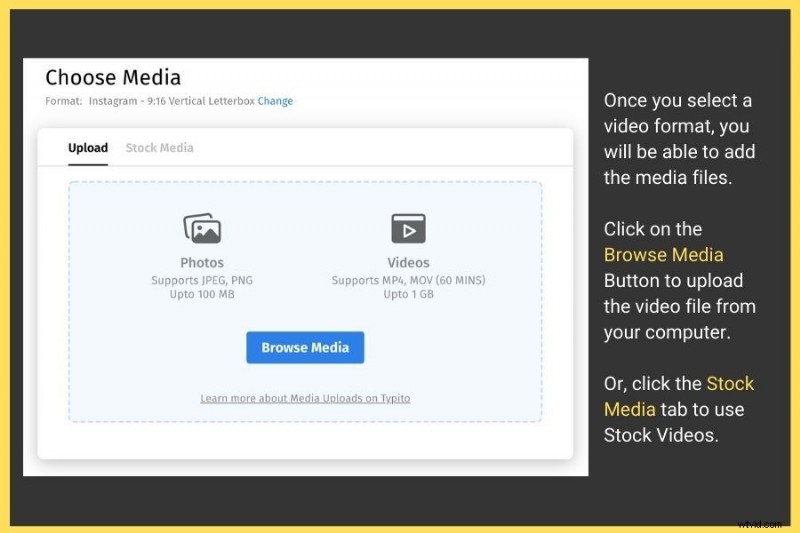
Consejo profesional: Puedes hacer dos cosas aquí:
- Hacer un video usando solo imágenes y música (Ver aquí)
- O bien, suba las imágenes en bruto que haya filmado con la cámara y haga que se vean profesionales usando las funciones integradas de Typito
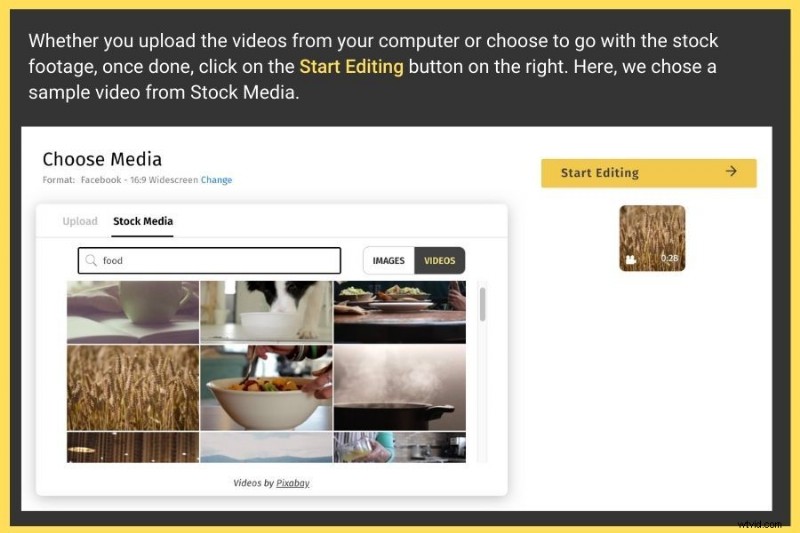
Según el tamaño del video subido, el proceso de importación demora desde unos pocos segundos hasta minutos. Una vez que haya terminado, haga clic en Empezar a editar botón desde la derecha.
Paso 3:Edita el video para darle un toque profesional
Se le redirigirá al panel de control fácil de usar de Typito con el metraje subido en el mismo formato (o dimensiones) que haya elegido.
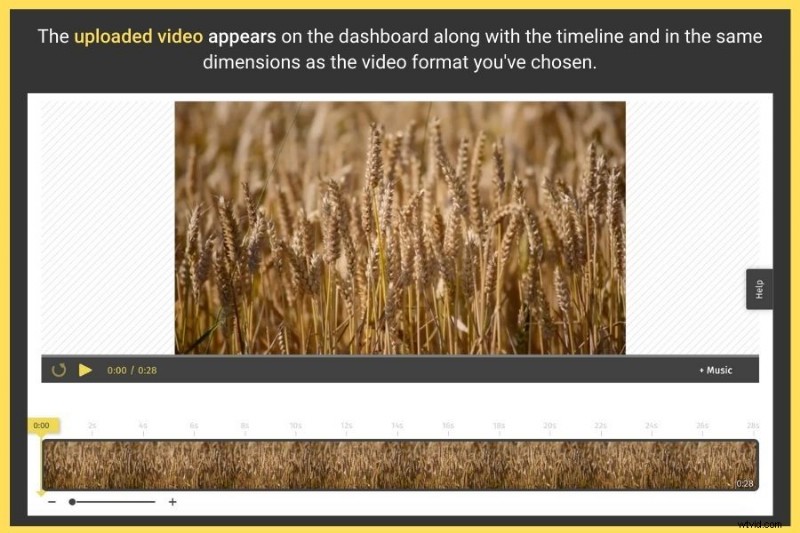
Verá 5 pestañas que le permiten agregar los elementos esenciales para crear un video atractivo en el panel izquierdo.
- Texto en video:títulos, tercios inferiores y CTA
- Superposiciones de imágenes
- Añadir música o audio
- Clips de vídeo e imágenes
- Subtítulos o subtítulos ocultos
Aquí hay un vistazo rápido a lo que cada uno de estos elementos puede hacer para mejorar tu video.
1. Agregando texto en tu video
Agregar texto a su video es bastante simple con esta opción. Esto es lo que debe hacer:
- Desde el panel izquierdo, haga clic en Texto pestaña.
- Verá una variedad de plantillas de texto prediseñadas para elegir. Si es un novato y probablemente no sabe por dónde empezar, le recomendamos que elija cualquiera de estas plantillas de texto estilizadas. Estos incluyen plantillas de texto básicas y animadas.
- Para aplicar la plantilla de texto a su video, haga clic en él una vez.
- Una vez que su plantilla de texto aparece en el espacio de trabajo de video a la derecha, puede embellecerla aún más cambiando el estilo de fuente, el color, el tamaño, la alineación, el espacio entre letras, la altura de la línea, etc. Además de estos, incluso puede agregar animación. efectos al texto.
La función de "texto" también incluye algunas otras subcategorías como:
- Títulos
: Abrir su video con un título de texto grande y en negrita asegura una gran primera impresión para su video. Elija una plantilla que se ajuste a su video de la colección de plantillas de títulos. - Redes sociales
: Agregar CTA en las redes sociales es una excelente manera de mostrar la presencia de su marca en múltiples plataformas. Puedes agregar llamadas a la acción para que los espectadores te sigan, según las plataformas de redes sociales en las que estés más activo. - Tercios inferiores
: Considere agregar subtítulos de texto colocados en la mitad inferior de su video para atraer a los usuarios que miran su video en silencio. Puede elegir entre varias plantillas de texto animado para darle a su video un toque estilizado más profesional. - De marca
: Si tiene un logotipo para su marca o fuentes particulares asociadas con su marca, esto es algo que definitivamente debería usar en su video. Cada una de las plantillas de marca le facilita agregar un logotipo a los títulos de sus videos.
Con solo hacer clic una vez en cualquiera de estas plantillas de texto, podrá agregarlo a su espacio de trabajo de video a la derecha. Luego puede arrastrarlo y colocarlo donde desee.
2. Agregando imagen a tu video
Puede haber ocasiones en las que necesite agregar algunas imágenes, formas o íconos en medio de su clip para obtener más contexto o simplemente superponer una imagen de su logotipo en su video.
Así es como puede agregar fácilmente una superposición de imágenes, formas o íconos a su video:
- Desde el panel izquierdo, haga clic en Imágenes pestaña.
- Ahora verá 3 opciones:Formas, Iconos, y Mis cargas .
- Formas e iconos: Incluye una variedad de formas geométricas predefinidas que puede usar en su video.
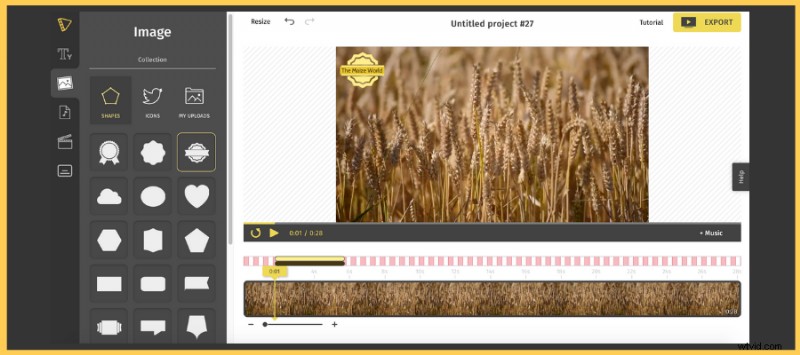
- Mis cargas: Esto le permite cargar sus propios logotipos o íconos que desea usar en su video.
Haga clic una vez en una plantilla para agregarla a su video a la derecha.
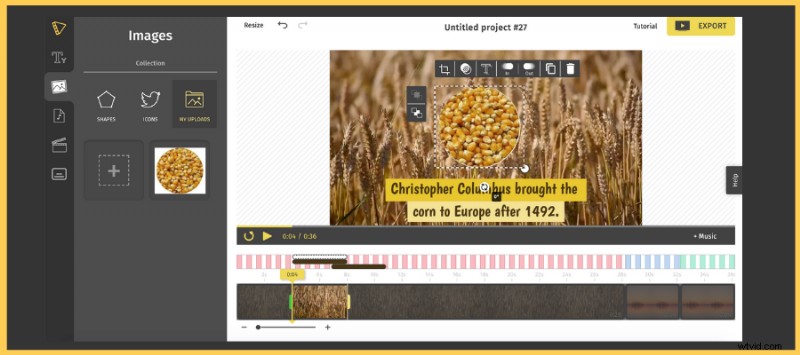
La música juega un papel clave en el aumento de la participación de tus videos. Esto es particularmente cierto si está creando un video sin texto, subtítulos o imágenes cautivadoras.
3. Agregando audio a tu video
Desde crear una buena introducción hasta agregar pistas según el estado de ánimo o ajustar el volumen de la música de fondo, puede hacer todo esto con solo un clic.
Así es como puedes agregar audio a tu video:
- Desde el panel izquierdo, haga clic en Audio pestaña.
- Verás dos opciones:Biblioteca y Subidas .
- Biblioteca :La biblioteca de audio tiene más de 150 pistas libres de regalías que puedes agregar a tu video. Puede navegar a través de múltiples géneros/categorías como:comida, fitness, empresa, aventura y más, para elegir una pista de música para encontrar música adecuada para su video.
- Coloque el cursor sobre una pista, haga clic en el botón de reproducción para obtener una vista previa y, si le gusta lo que escucha, haga clic en + Agregar para agregarlo a tu video.
- Subir :Si desea cargar su propia pista, simplemente haga clic en el botón Cargar y elija su archivo de audio desde su computadora.
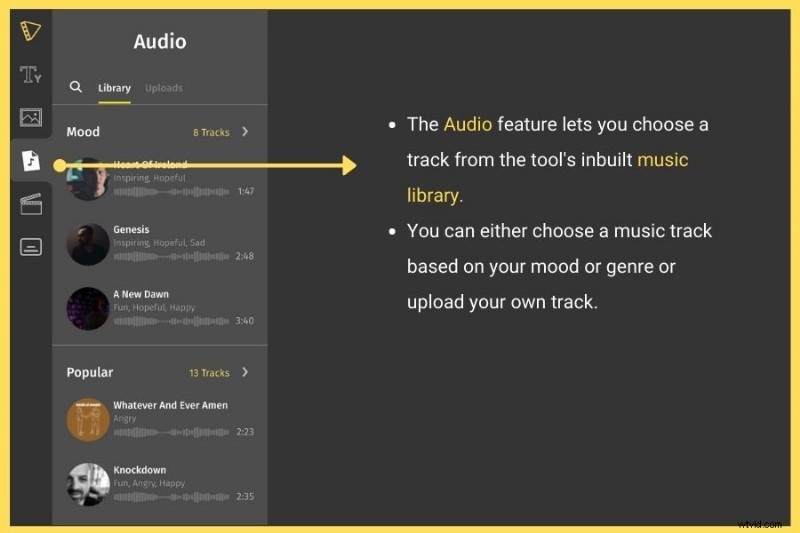
- No importa cómo agregues la música, en el momento en que la apliques, obtendrás una ventana emergente con una opción para recortar el audio. con la ayuda de un control deslizante arrastrable. Esto le permite usar una parte específica del audio para el video.
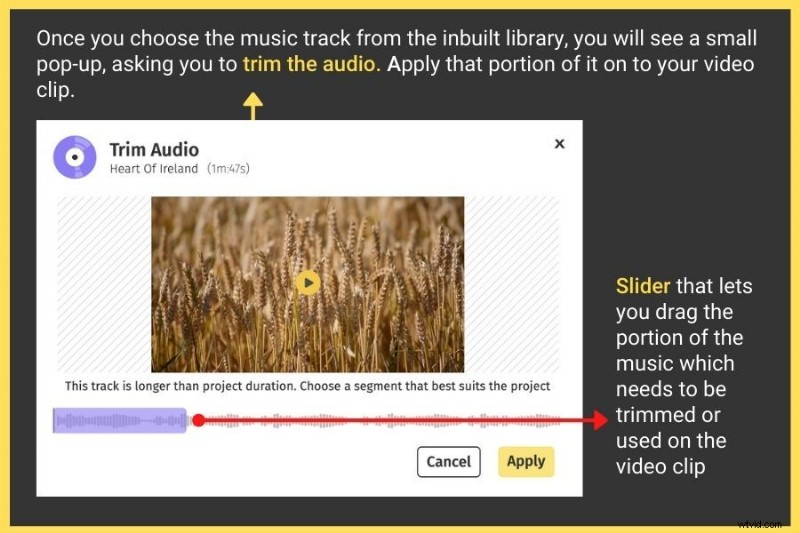
- Después de agregar la música al video, tiene la opción de cambiar el volumen tanto del fondo como de la música en cualquier momento.
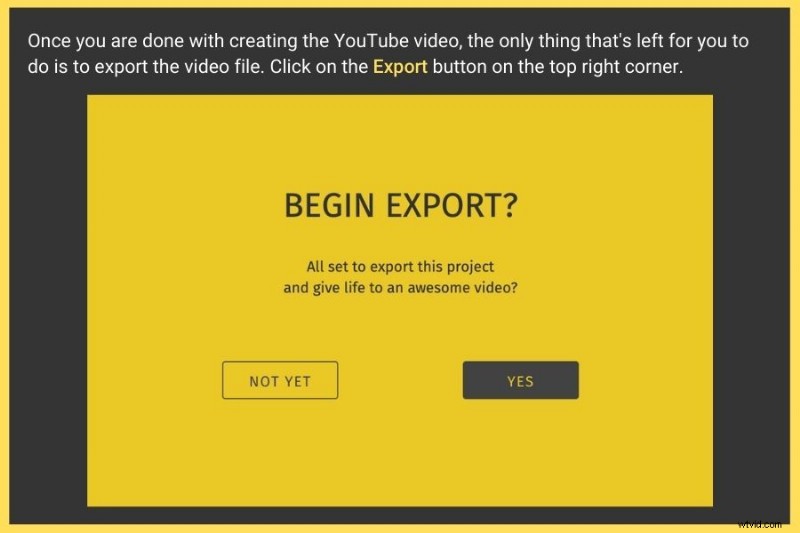
5. Agregando imágenes a tu video
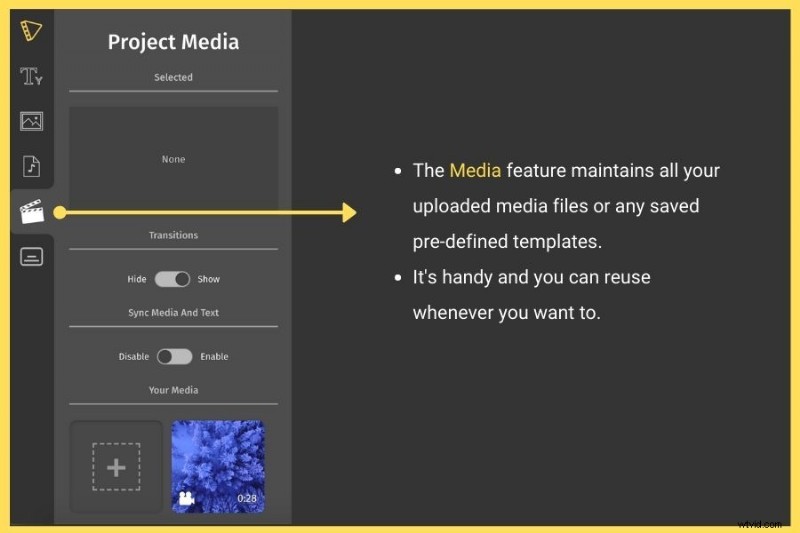
Los medios le permite cargar imágenes o más clips de video y unirlos para crear un video, como una presentación de diapositivas o clips de imagen con algunos efectos de transición o compilaciones de video.
6. Agregar subtítulos a tu video
Los subtítulos son una excelente manera de hacer que tus videos sean más accesibles y atractivos. It allows hard-of-hearing and d/Deaf individuals to not just watch and enjoy your video content but also ensures that they remember the information more easily. More than that, it’s also great for people who prefer watching videos in sound-sensitive environments.
With Typito, adding captions is easy and straightforward. Here’s what you need to do:
- From the left panel, click on the Captions icon.
- You will see a wide array of basic and stylized text templates.
- Choose any one of the text templates that you like to add to your video and click once.
- This gives a preview of the way it looks on the video.
- You will also see something called Position , which is basically an option to align the captions to top, middle, or bottom .
- Once you’ve aligned the captions, the next step is to click the “Next, add content ” button.
- You will then be prompted to add the content for your captions.
Step 4:Export the video and download
After you have played around with all the features and perfected your video, you just have to download it. To do this, follow these steps:
- From the top right corner, click on the Export button.

- Your video begins to export. This takes from a few seconds to minutes, based on your video size.
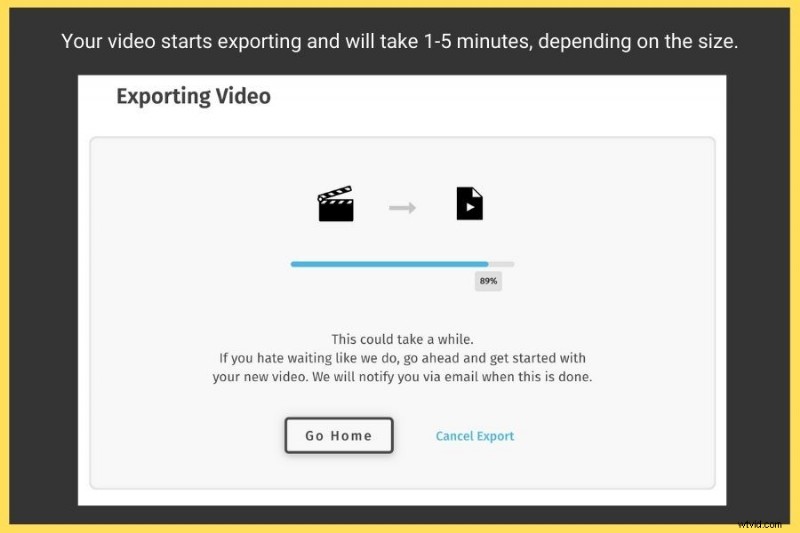
- Once that’s complete, your created video is ready to be:
- Downloaded in HD format and saved to your local drive
- Published to your YouTube channel directly
- Shared on Facebook
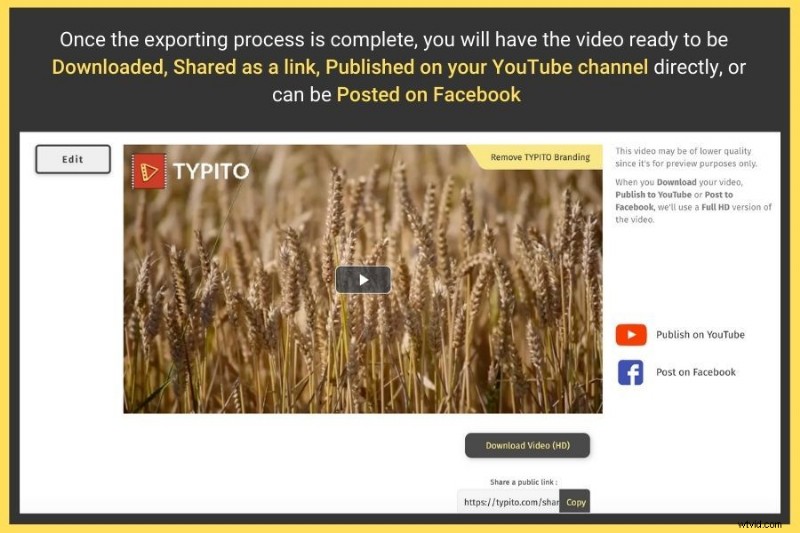
Now that you have learned how to make a video online for free, learn a few more essential video-making tips before you start making one.
Tips to Keep in Mind While Making a Video
If you’re nervous about making your first video, you aren’t alone. Most aspiring vloggers and videographers face the same hurdle after starting a YouTube channel or video project. Most of them can’t seem to understand how to make riveting video content with a modern vibe.
If you’re among the aspiring stars and cinematographers, here’s a chance you wouldn’t want to miss because in this blog you’ll learn the tips to keep in mind while making a video. So stick around till the end as we walk through the essentials that you’ll need even before getting started.
A lot of preparation goes into pre-production to get each shot right so that you don’t have to take the same path twice. My approach in this blog is to break down the process into smaller bits so that you can pause and practice each technique as you scroll.
Not to sound preachy, but you don’t have to spend a whole lot of money to become a professional video maker. At least, your first video needn’t be shot on a high-end camera, even a mobile phone makes a great tool to get the video professionally shot and edited with an easy-to use video editing tool like Typito.
Legends Make Videos and Not Clickbait
Congratulations on taking baby steps to launch your video project. The next stage is getting smaller things sorted. That includes brushing basics and keeping tools handy to start and finish the project within a stipulated time.
So without ado, let’s begin with tips that nobody talks about.
1. Light Brings Videos to Life
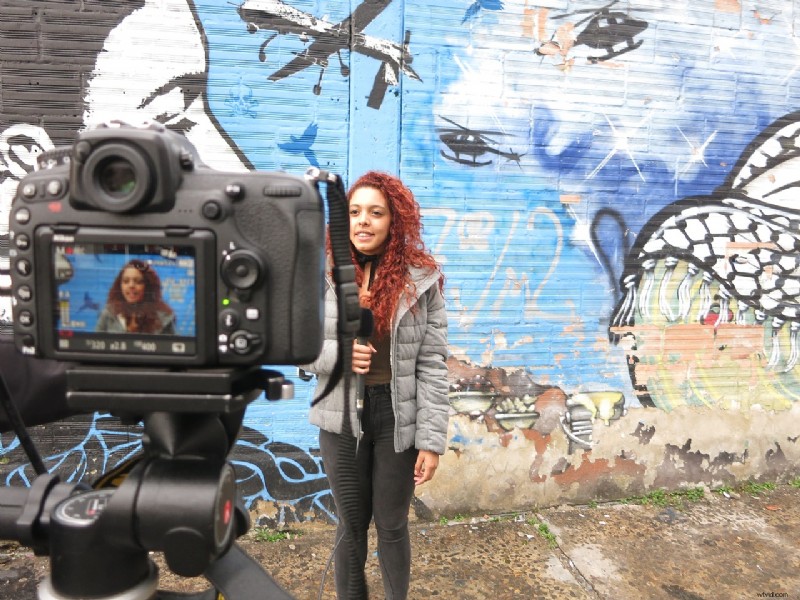
In cinematography, light shapes mood. It adds production value and makes the video richer and expressive. A soft light hitting the face brings the focus onto an object or character in your video while a bright dispersed light is more straightforward and general.
A misplaced light source clashes with the quality of the production and makes the video seem budget-strained. Natural light is strangely appealing in videos so shooting during the early hours and evening adds drama to scene composition.
At all costs, avoid shooting in piercing bright midday light to avoid dealing with unflattering shadows. It’s every video editor’s nightmare. While shooting indoors, experiment with symmetrical lights to illuminate the face and add intensity to the scene.
If you’re shooting marketing videos always leave the face well-lit for a positive vibe. If you’re taking the pro steps, it’s worth trying the lighting triangle to let the light flow around the features of your subject to create a pleasing composition.
2. Use Background to Compose Scenes

The background in a video is just as important as the foreground. If you are planning to compose a professional shot, choose the background wisely, and remove all distractions from the scene. Use a solid backdrop like heavy drapes and decorative paper to fill the void.
The most important thing is to make sure to place actors away from the backdrop to avoid inadvertent shadow casts. If you can’t make do with props available at home, rent a studio to use as a filming set.
When shooting at unfamiliar sets, be aware of reflective surfaces and window panes that reflect equipment or behind the scene crew. Moreover, placing actors near windows where outdoor light enters can cause unnecessary silhouettes.
3. Pick a Video Editor to Improve Quality

So you’ve got the production completed, what’s next? Raw footage is not a presentable material on its own. It must go through post-production where editors transform the footage by adding flavors like SFX, VFX, and also editing away unnecessary bits to arrive at a final version.
Even if you’re a beginner, make sure to use simple editing tools to make your footage appealing. These can take your video processing to whole new heights.
Some of the simpler features that you can exploit from free editing tools are text inclusion, cropping, scene transitions, and modifying aspect ratios. Some mid-tier versions also support filters, overlays, as well as stock audio and video.
4. Don’t Overdo the Edits

When you try the editor for the first time, be prepared to feel overwhelmed by its features. Only pick effects that increase the production quality and discard the rest.
In most scenarios, your footage may not need one or any effect at all. It’s always better to avoid going overboard with edits.
However, a few things are mandatory - Like using noise cancellation to remove background noise, adjusting brightness, cutting unwanted pauses, adding cool transitions, and BGM.
5. Use Audio to Make an Impact

Have you ever had to click a YouTube video and then immediately close it because of bad audio? It’s wired into humans to reject unappealing content, especially the audio.
Most people are patient enough to watch videos that may not be HD or if videos appear slightly grainy. But distorted audio is enough to make them pay no heed. So before making your first video, make sure you have set aside a small budget for an external microphone.
If you aren’t short-strapped, it won’t hurt to spend a little more on an HD microphone. After recording the audio from an outdoor location, edit away distractions like birds, wind noise, and traffic to call the viewer’s attention to a particular activity.
6. Use Image Stabilization

One important thing to remember in video-making is to record visuals without making viewers feel dizzy or seasick. Unless it’s part of the script, jerky videos will have people cursing you for not using a stable platform.
If you have shaky hands or aren’t set up to shoot hand-held, it’s best to set down the camera on an immovable surface (or use a gimbal or tripod if you have money to spare). Your skill will be put through paces when panning the camera. The smoother you do it, the more professional it seems.
However, if you can’t pan without ruining the production quality, consider changing perspective by cutting shots and making transitions.
If you still have shaky scenes in your master footage, use a video editing tool with image stabilization to fix the flaw. It’s mostly a one-click operation so it isn’t an exhausting effort. Alternatively, you could shoot using a video camera with built-in image stabilization.
7. Use Rule of Thirds to Compose Shots

If you insist on taking a professional approach, go with the rule of thirds to achieve pleasing footage.
According to this technique, the subject is placed along with the intersecting points on the grid lines. That is where the camera sensor captures the best details. It also adds a cinematic effect to the shot than having the subject stand in the dead center.
However, the rule of thirds isn’t always a textbook approach. It’s only a creative step to achieve unconventional results. If you’re a budding video maker, this is one of many important skills that’ll come in handy when regular shots start to seem unsuited.
8. Your Phone is a Great Video Making Tool

Thanks to Apple and its iPhone series, mobile photography exploded into a fad that people still follow. It’s a new genre where you don’t even have to own a DSLR to capture visuals. Instead, professional shots are conceived using just a mobile phone.
With manufacturers cramming more megapixels they can to phone sensors, it’s gotten better for end-users. Although not a replacement for pro SLRs, it does unarguably well compared to entry-level and mid-range SLRs. But be mindful of caveats if you’re going with mobile videography.
Shoot using the main camera because that’s where the sensor is bigger. Most selfie cameras on high-end mobile phones don’t fare as much as the main rear camera.
Shoot in the landscape to achieve the 35mm effect. It captures more details that improve video production quality on a larger screen. If possible use the overlay grid to maintain the level.
9. Create a Production Plan Before the Shoot

Above everything else, it’s important to meticulously prepare a plan beforehand to avoid last-minute changes. Impromptu shoots are great for a family occasion where moments weigh more than precision.
But if you’re stepping into the world of professional cinematography or if you want to make a career out of film-making, the complete schedule must be well-coordinated to avoid expenses from adding up due to disruptions.
Plan your production in stages and make sure to note progress, meeting deadlines, and time management. If you need a leg up in setting a basic production timeline, here’s what you need.
Start with production goals. Prepare questions like what you want to convey through your script and who will watch it and how your video will speak to viewers.
Whether shots will seem like a first-person/third-person perspective or a different one that isn’t tried before matters in production. You’ll be confronted with more questions as you get started and build momentum.
Once your goals are set, begin with scriptwriting and storyboarding. Most first-time video makers rush scriptwriting and stop abruptly when they’ve wandered off from the focus. It’s a learning experience, so don’t hesitate to revise portions till you’re satisfied with the way your script sounds when read out loud.
Here, being concise is the key to keep the audience riveted. Don’t prolong narrative portions unless it has any production value.
With the attention span of a goldfish, most content consumers would want excitement when the button is punched. They tend to become impatient when the plot slows down before getting to the interesting bits.
Conclusion
If making a video has been your life-long passion, get started now and use these tips to sharpen individual bits of production to make you make your video praise-worthy. I am sure, doing so will help you become a great filmmaker in the days ahead.
Most newbie filmmakers go through a vicious cycle of reworking their approach till it’s polished to perfection. Don’t forget to emulate the methods of rule-breakers because there is no single right path in video-making.
Modern video makers are constantly exploiting props and stage elements in bizarre ways to make shots shimmer. They do so, by deliberately deviating from traditions to get their work nominated for outstanding elements.
Someday, you could become an innovative filmmaker with a signature style that your movies will be associated with. So work persistently, and learn from mistakes to perfect your shots.
